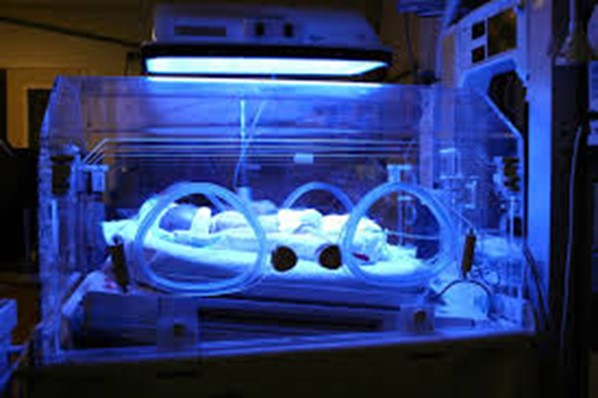The nurse is preparing a 4-day-old infant with a serum bilirubin level of 19 mg/dL (325 µmol/L) for discharge from the hospital. When teaching the parents about home phototherapy, which instruction should the nurse include in the discharge teaching plan?
Total Bilirubin Reference Range: Newborn: 0.1 to 10.5 mg/dL (1.7 to 180 µmol/L)
Feed the infant every 4 hours.
Perform diaper changes under the light.
Reposition the infant every 2 hours.
Cover with a receiving blanket.
The Correct Answer is C
Choice A reason: Feeding the infant every 4 hours is not a specific instruction for home phototherapy, which is a treatment that uses blue light to break down excess bilirubin in the skin and blood. However, feeding the infant frequently is important to promote hydration and elimination of bilirubin through urine and stool.
Choice B reason: Performing diaper changes under the light is not a recommended instruction for home phototherapy, which is a treatment that uses blue light to break down excess bilirubin in the skin and blood. The nurse should instruct the parents to turn off the light and cover the infant's eyes with protective goggles or patches during diaper changes to prevent eye damage or irritation.
Choice D reason: Covering with a receiving blanket is not an appropriate instruction for home phototherapy, which is a treatment that uses blue light to break down excess bilirubin in the skin and blood. The nurse should instruct the parents to keep the infant unclothed except for a diaper and eye protection during phototherapy to maximize skin exposure to the light and increase its effectiveness.

Nursing Test Bank
Naxlex Comprehensive Predictor Exams
Related Questions
Correct Answer is C
Explanation
Choice A: Straining all urine is not a relevant instruction for the nurse to provide, as this is not related to prostatitis. This is a distractor choice.
Choice B: Maintaining contact isolation is not a necessary instruction for the nurse to provide, as prostatitis is not a contagious condition. This is another distractor choice.
Choice C: Avoiding urinary catheterization is an important instruction for the nurse to provide, as this can introduce bacteria into the urinary tract and worsen the infection. Therefore, this is the correct choice.
Choice D: Restricting oral fluid intake is not an appropriate instruction for the nurse to provide, as this can lead to dehydration and reduced urine output, which can increase the risk of urinary stasis and infection. This is another distractor choice.
Correct Answer is D
Explanation
Choice A: Increasing oral fluids may help with hydration, but it will not reduce skin flushing caused by lisinopril. Lisinopril is an angiotensin-converting enzyme (ACE. inhibitor that dilates blood vessels and lowers blood pressure. Flushing occurs due to increased blood flow to the skin.
Choice B: Nitroglycerin is a vasodilator that relaxes smooth muscle in blood vessels and reduces chest pain caused by angina. It is not indicated for skin flushing caused by lisinopril. Moreover, nitroglycerin can lower blood pressure further and cause hypotension, headache, dizziness, and fainting.
Choice C: Going to an emergency department is not necessary for skin flushing caused by lisinopril. Flushing is not a sign of an allergic reaction or anaphylaxis, which would require immediate medical attention. Flushing is also not a symptom of a heart attack or stroke, which would present with other signs such as chest pain, shortness of breath, arm numbness, or slurred speech.
Choice D: Reassuring the client that facial flushing is a common side effect of lisinopril is the best action for the nurse to take. Flushing is not harmful or dangerous, and it usually subsides within a few hours. The nurse should explain the mechanism of action of lisinopril and its benefits for lowering blood pressure and preventing angina. The nurse should also advise the client to monitor his blood pressure regularly and report any signs of hypotension, such as dizziness, lightheadedness, or fainting.
Whether you are a student looking to ace your exams or a practicing nurse seeking to enhance your expertise , our nursing education contents will empower you with the confidence and competence to make a difference in the lives of patients and become a respected leader in the healthcare field.
Visit Naxlex, invest in your future and unlock endless possibilities with our unparalleled nursing education contents today
Report Wrong Answer on the Current Question
Do you disagree with the answer? If yes, what is your expected answer? Explain.
Kindly be descriptive with the issue you are facing.
